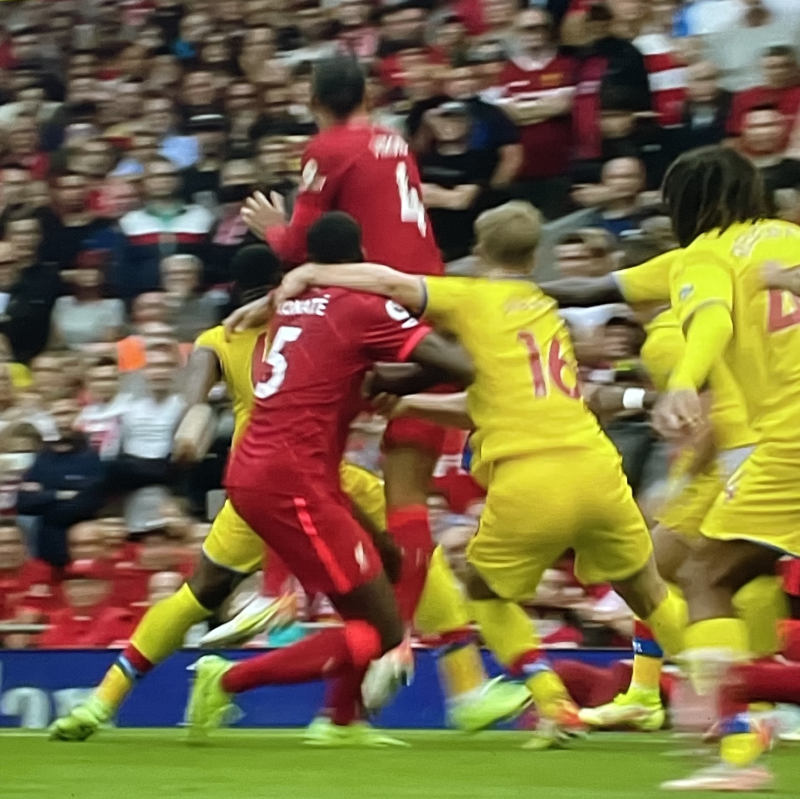
To expand on my match report for subscribers as part of our bumper new-style post-match analysis (which also includes analysis from Andrew Beasley and Daniel Rhodes), I’m sharing this free piece on just how unstoppable Liverpool have become at set-pieces.
There appears to be some real next-level thinking involved, as you’d expect from the team that, without petrodollar backing, has to balance the books and look to be smarter.
Match of the Day pointed out last night that Liverpool have scored 25% more league goals from corners than the next-best scorers since the start of last season.
The Reds have six set-piece goals already this season in five league games, and of course, beat AC Milan with a volley from a corner.
… Yet Liverpool went over half of last season without scoring a single goal from a corner or free-kick.
This coincided directly with the injury to Joel Matip (after the loss of Virgil van Dijk months earlier), and the use of three below-average height centre-backs who, in this time when the team scored zero set-piece goals, conceded five.
So, essentially, Liverpool have scored 25% more corner goals than rivals, in a season and a bit, despite going over half a season without one.
Giants!
First of all, let me take a quick look at how much players, in general, are taller now. This is also to be used in relation to players like Pascal Struijk and James Tarkowski launching last week with both feet off the ground; Struijk accidentally (but recklessly) dislocating and fracturing Harvey Elliott’s ankle, and Tarkowski looking to break Richarlison into pieces (which is an urge I understand, but the tackle remained reprehensible).
While the new refereeing edicts seem to be about letting the game flow, it seems to be more about clamping down on the perceived divers (usually fixated on as being foreign) and allowing more brutish football to flourish.
Why do I say this? Well, if you really want to speed up the game, what about the 30-60 seconds wasted with every single free-kick when the players stand two inches from the ball and don’t retreat as required? What happened to a hurried retreat to ten yards? What was a clear yellow card a few seasons back is now never punished, so the game is slowed by time-wasting and fouls that are given are allowed to not just stop breaks but really, really, really slow the game down and allow everyone to get back.
And time-wasting, while often pointed out by refs, is never added on to the end; so it serves to slow the game, without the game being extended. But that’s another issue; the PGMOL is a band of bad bald cronies (speaking as a bad bald dickhead).
My unofficial survey of heights, which I will cover below, is a bit mixed in terms of methods, but the current heights are accurate.
Klopp Inherited a Tiny Team
When Liverpool had set-piece woes at both ends in 2015/16, I noted the lack of aerial ability in the team Jürgen Klopp inherited. (Christian Benteke was a rare outlier, but not good enough as a footballer.)
It was the shortest side in the top flight, and had the worst aerial win percentage as a side. I looked at what were, at the time, his first 14 Premier League games, and his side averaged 179.3cm tall, which is 5’10”. (Note: all team heights I used are for the starting outfield ten, as goalkeeping height, while important, only really applies in one box – unless you’re Alisson and it’s May 2021.)
I tracked the heights of all Liverpool’s opponents, and the taller they were on average, the more set-piece woes Liverpool had. All the goals the Reds conceded in those 14 games were when there was a big height differential between the two teams, and the same was often true last season.
The graph below also takes the Liverpool team of 1982/83 (the ten players who played the most games), as an unofficial comparison to the days of yore. It was not a short side on average – this was no ‘70s Leeds United of Billy Bremner and Johnny Giles, who were both smaller than Sammy Lee. (And even the giant Jack Charlton was only 6’1”.)
To show how potentially gigantic teams are now, I used the tallest of outfield Xs for each club in the first three league games this season, although all of the teams had unused players who could make their sides taller yet. And this is before getting onto the conversion from slim players to rugby-physiques. Graeme Souness was a decent height and a very solid build, but he was 12 stone; Romelu Lukaku was 17 stone when he left Man United for Inter Milan.
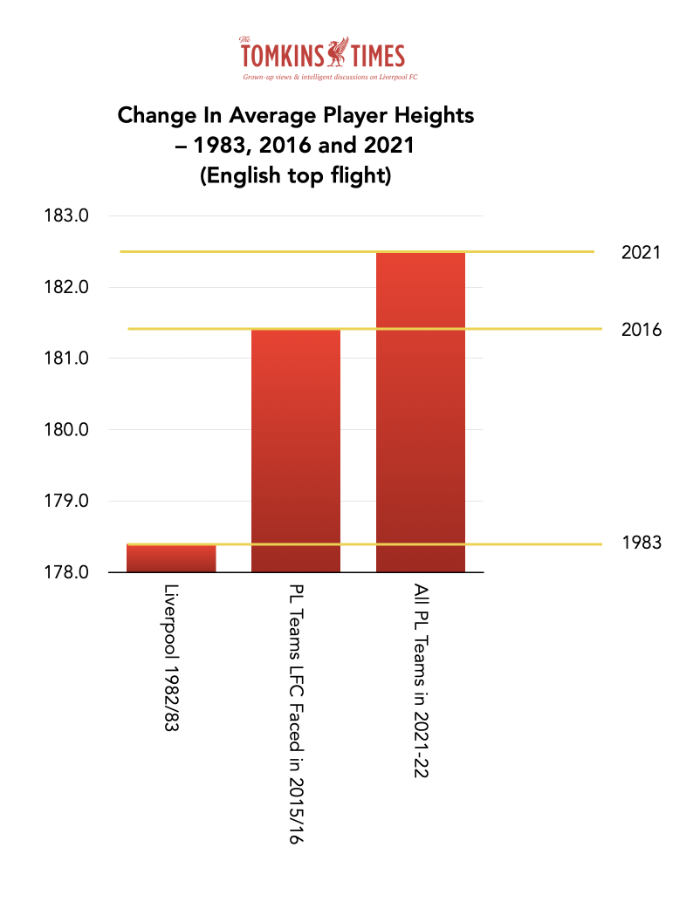
Anyway, you can see how – despite the ongoing prevalence of tricky small players in the English top flight – the number and size of giants in teams has increased, while some teams are just rammed with 6’3” sledgehammers. It seems there’s a significant increase in height in just five years.
This is the era of the bodybuilder player. This is why sliding, jumping, lunging tackles need to be outlawed, even if they take the ball, if they endanger an opponent; you can still (at times) make a clean and safe sliding tackle, but the angle has to be right, and the ball there to be taken cleanly without any kind of scissor movement. Anyway, that’s another issue.
Small Strikers
Liverpool play with four main forwards who can head the ball, but who range from 5’9” (Sadio Mané and Mo Salah), through 5’10” (Diogo Jota) to 5’11” (Roberto Firmino). They are in the team to move with pace and skill, to create space, to run with the ball, and to score goals. They are not there to win aerial duels.
They succeed in heading when in space, but in aerial duels they are understandably hopeless. And set-pieces are all about aerial duels – or working the space to get unmarked.
Plus, in addition to no big striker, Liverpool’s midfield often contains one of Thiago (5’9”) or Naby Keïta (5’8”), having almost always contained Gini Wijnaldum (5’9”), who had a great leap but still didn’t win many aerial duels in the opposition box (albeit he did famously win a vital one here and there). Liverpool’s main full-backs are also both under 6ft, and they’re often the ones crossing anyway. They do not get in the opposition box for set-pieces.
This means the height can only really come from two of the midfield positions, and the two centre-backs. It means just four options for big guys, in part as Liverpool want to play clever football, not aerial football.
Yet last season, Liverpool were without not only van Dijk and Matip (plus Joe Gomez, average-height for the position at 6’2”), but Jordan Henderson, and at times, Fabinho. Ozan Kabak arrived with a great aerial duel success rate in Germany, but as seen with other players, it meant nothing in England, where being 6’1” is often not enough. He got bullied.
In time, with age, experience and additional weights work, improvements can be made, but as I showed in 2016, for every average inch increase in height, the greater the number of aerial duels won per game, once over 5’10”. (So, under 5’10” it’s less consistent, but still follows the same trend overall.)
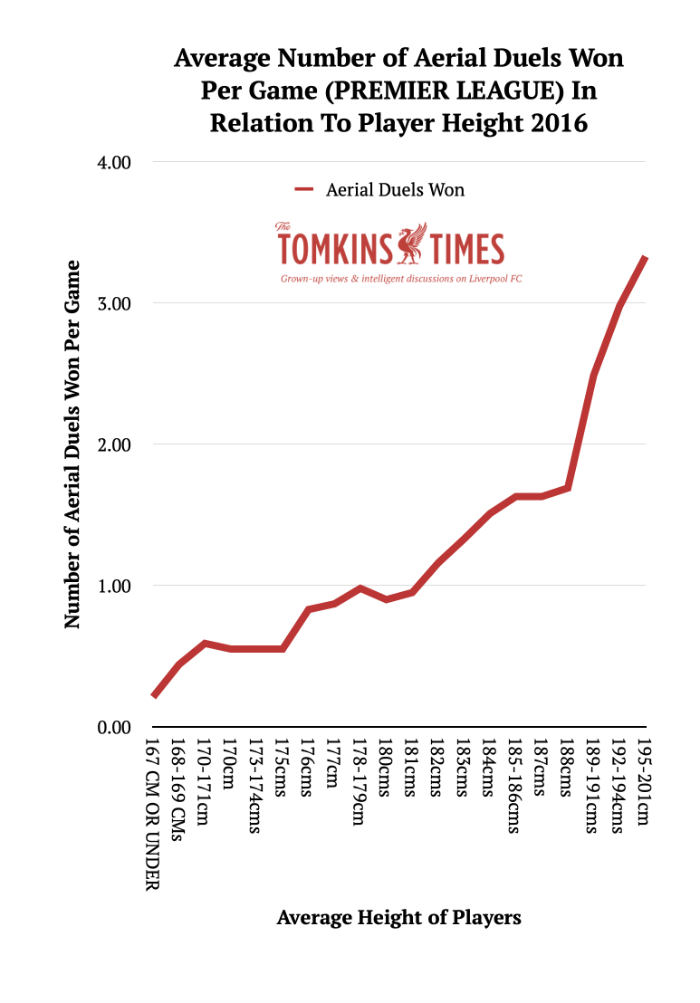
Both van Dijk and Matip are in the top ten for aerial duels won pretty much every season, looking at +500 minutes played and 20+ duels contested. At times they’re top.
Everyone said that Fabinho moving back into midfield was the reason the Reds form turned around last season, and while I think it helped, the introduction of Rhys Williams alongside Nat Phillips was, to me, the vital factor. Liverpool had gone 20 league games without a set-piece goal.
Four games remained: Manchester United, West Bromwich Albion, Burnley and Crystal Palace. They also happened to be four of the tallest teams. (Weirdly, Liverpool have already played two of these teams this season, too, and also had set-piece success against them.)
Prior to those final four games, Liverpool played Southampton with Williams and Phillips. Against Leeds and Newcastle, in the two preceding games before that, the Reds’ centre-backs were 188cm and 186cm. Leeds scored from a corner. Liverpool beat Southampton, but extended the run to 20 league games without a set-piece goals. Then came those four crucial games.
From 188cm (6’2”) and 186cm (6’1”) the Reds went to 190cm (6’3”) and 195cm (6’5”), with 188cm (6’2”) Fabinho moved back into the midfield.
From no set-piece goals in all of 2021 up to May, six arrived in those four games. And the chaos of giants played a role in them all.
The Chaos of Giants
Now, Nat Phillips is tall – but not the tallest. At 6’3” he is very aggressive; he won a good (but still unremarkable) number of aerial duels, to improve massively on the subpar, sub-height Kabak, Fabinho and Henderson.
But Rhys Williams, gangly and 19 (turning 20 later in the season) at 6’5”, seems to have little leap and little timing. He’s raw. His headers at goal from set-pieces were almost universally dreadful, and to be fair, Phillips seemed to have a 50p-head in the opposition box, one effort aside. It’s a different skill to head at goal, rather than heading away.
Yet Williams was the best aerial duellist in the league last season, averaging close to 90% won. The only player I’ve seen actually hit 90% since I started tracking this in 2016 was Joel Matip, also 6’5”, when the Reds won the league. Neither is a great leaper; both are giants.
But Williams was a presence. Both he and Phillips caused chaos, despite neither having scored a professional goal at that point. Matip can get a few goals per season, and van Dijk once got ten for the Reds and Holland in a calendar year, but these rookies were simply tall, with zero goalscoring track record.
Now, one fact that was too subtle to be noticed unless you mined the data was that, going into the 2020/21 run-in, Roberto Firmino was joint with van Dijk for set-piece goals scored for the Reds since the summer of 2018, albeit van Dijk had missed most of the season that was unfolding. (Of course, the Reds started that season with a flurry of set-piece goals.)
As I kept noting, Firmino’s goals often came via set-pieces where, at 5’11”, he wasn’t big enough to assiduously mark, but good enough to head in if he got free. He just had to get free. Against Spurs at the end of 2020, he got free. Why? Rhys Williams, in a rare start, was standing next to him. People noted Firmino’s drought, but never this key reason.
Williams returned to the team in May, and et voila, Firmino’s set-piece goals returned. And weirdly, Alisson even got to score one, too.
Again, it’s vital to realise that if your two wide strikers are scoring 50-75 goals per season between them (while the stand-in wide strikers perhaps add another 10 in total), then the centre-forward being in the box all the time would get in the way. Firmino could goal-hang and get 15 more himself, but the team might lose 30 in the process.
A lot of the time, Firmino’s job is to vacate the box at just the right time, to create the space for the outside-in runs of Salah and Mané; sometimes to lay on the pass or backheel as well. Set-piece are a rare area of the game where he’s always in the box.
Now, Williams had gone off by the time Alisson scored, but look at it again, and the Reds’ keeper, unmarked, steals in when Phillips is launching himself at the ball. This is The Chaos of Giants: 6’3” centre-back and 6’4” keeper both going for the same ball, and the keeper got their first.
Judo Moves
While opponents used literal judo on Liverpool’s tall centre-backs as the Reds attack corners, Liverpool have judoed them back, with the ultimate cunning that the phrase suggests. They are using the opponents’ aggression and cheating against themselves. (Note: I also hated it when Martin Skrtel held opponents rather than contesting the ball.)
Teams are obsessed with van Dijk and Matip, as they should be. If you don’t double-mark them, you’re screwed. Palace were also obsessed with the giant Konaté yesterday, as they should have been. But just look at what it does to help Liverpool.
In previous seasons I was driven to despair by the way van Dijk and others were literally wrestled to the ground by various players. But now, it seems that Liverpool are using this against their opponents.
Go ahead and do that, they seem to be saying. We don’t even care about the penalties we should be getting, they seem to be saying. We’ll just use this against you.
Remember, it’s now 11 set-piece goals in the last nine league games for the Reds, and they’ve won eight and drawn one. That’s 25 points in nine games; but the 20 games without a set-piece goals reaped just 26 points. It’s taken just nine games to more-or-less match what took 20, and set-pieces are the key.
Now, Liverpool play brilliant, fast-flowing football, and that create chances. They are not a long-ball team, unless it’s a raking van Dijk or Trent Alexander-Arnold rangefinder. They have no big strikers to hit long balls to, so it has to be accurate long passes, into feet or into space.
While it’s not been the toughest run of five games, these are still teams who can be hard to break down (at least, Burnley and Palace), and you can see from the proper preseason and most of the best players being fit how electrifying and devastating the Reds’ play is once more. Shots, shots, shots = goals, corners and goals.
The relative lack of new faces means now awkward transitional periods – as in 2019/20, everyone knows their job, and the years of developed team interplay trumps the novelty of a new guy who isn’t on the same wavelength yet (and who may never get onto it).
Yet set-pieces often account for 30%-or-more of the goals in football. If you cede 30% of your scored goals because you’re too short, and then concede more than usual at the other end, the fine-margin wins become draws and defeats, no matter how good your football is. (Liverpool also barely won a penalty in that time, too, but conceded several. Which didn’t help.)
But in a moment, let’s look at some stills from these games to show what I mean about the Reds judoing the opposition’s rugby tactics.
The more opponents focus on the (legally) unstoppable van Dijk, Matip, Konaté, Phillips and Williams in these run of games, the more space it leaves all the others. And the others mostly score the goals.
If the defending team get a header clear from 8-10 yards out, whilst trying to also hold down van Dijk et al, then where will the ball go?
If the defending team put seven or eight around the three or four Liverpool players who are not making late runs into the box, but standing there asking to be marked, who can get free?
Just three of these 11 corner/set-piece goals in the last nine league games came from clear first-time headers. They mostly came from second balls, rebounds, scraps in the chaos, but where positioning counted. And again, these were all against teams of giants who, overall, towered over the Reds; but where Liverpool having four really big bastards really, really helps.
It’s like Liverpool have said “you can neutralise van Dijk and Matip with your five or six players and even foul them if you want”, and then they’ll deal with the second ball. Yet if they don’t seek to neutralise van Dijk and Matip – bam, they’re done on the first ball.
Goal Analysis
The identities of the players are often fairly obvious, but I added the key names for last season’s goals.
While this may help opposing teams see how Liverpool work, I assume the professional scouts can see this kind of thing anyway. But the point is, how to stop it? That’s why it’s so fiendishly clever, as I don’t see how you can.
It’s like trying to decide if you want to be shot in the head or in the heart.
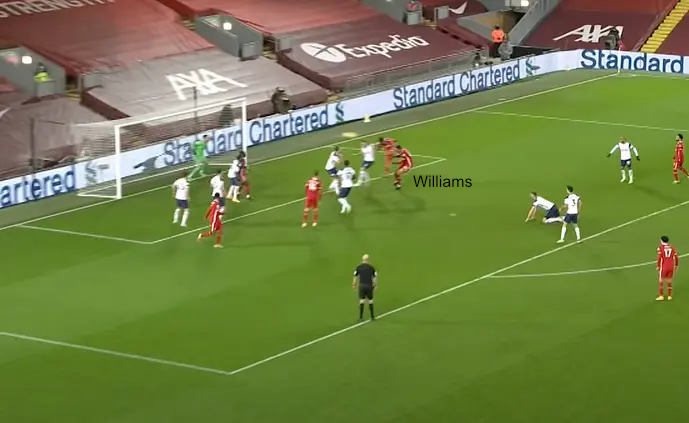
Late 2020, and Firmino scores because Rhys Williams is in the mix. Williams then is barely seen again aside from a tricky time in the FA Cup at Man United. This is Liverpool’s last set-piece goal until the final weeks of the season.
But Williams returns for the last five games, and this time he has more luck at Old Trafford.
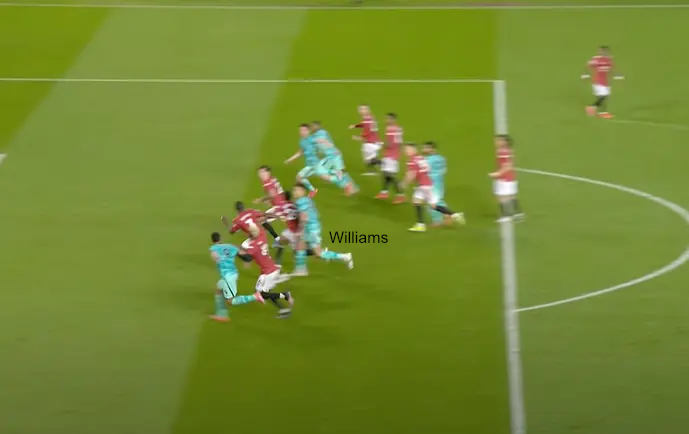
Here, three tall guys are marking Williams and the ball goes over them all, to the free Firmino, who heads in against Man United.
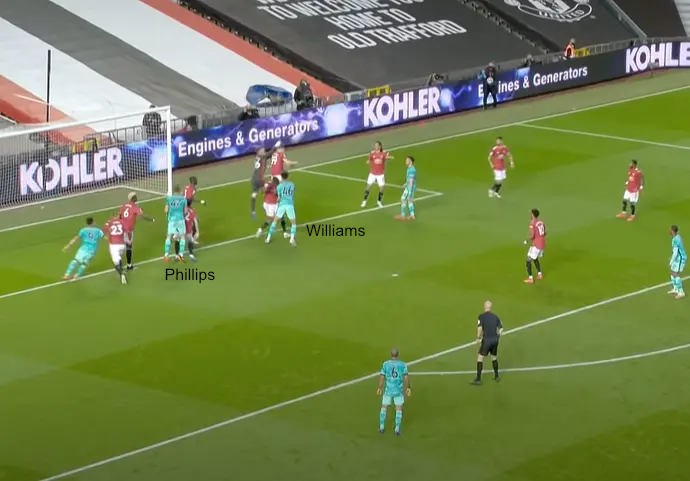
In the same game, a goal came from Williams causing panic in that central area, eight yards out. The ball fell and Liverpool bundled it home.
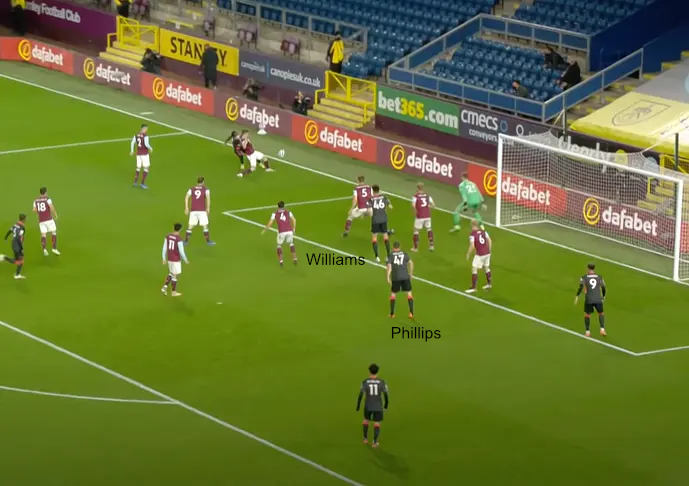
Against the brutish Burnley, Phillips heads home from a cross, albeit from a worked-routine and not a corner delivery. Williams has half the Burnley team around him, and Phillips is not even half marked. Interestingly, both Firmino and Salah are lurking. They are not needed this time.
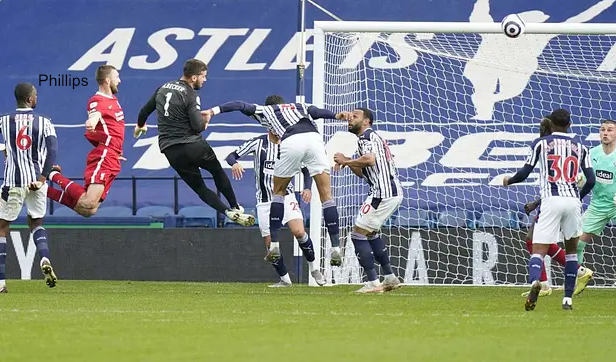
You can see that this is Nat Phillips trying to head the ball, but I added his name anyway. Alisson sneaks in between Phillips and the West Brom defender. I can’t remember what happened next…
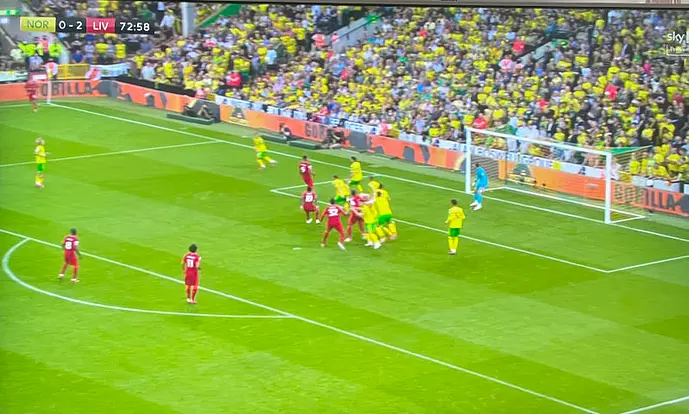
As against Burnley last season, Mo Salah is lurking. Norwich put so many players around van Dijk and Matip – fouling van Dijk – that they cannot spread the “blanket” beyond eight yards out. Naby Keita is also lurking – I wonder if that will ever prove effective?
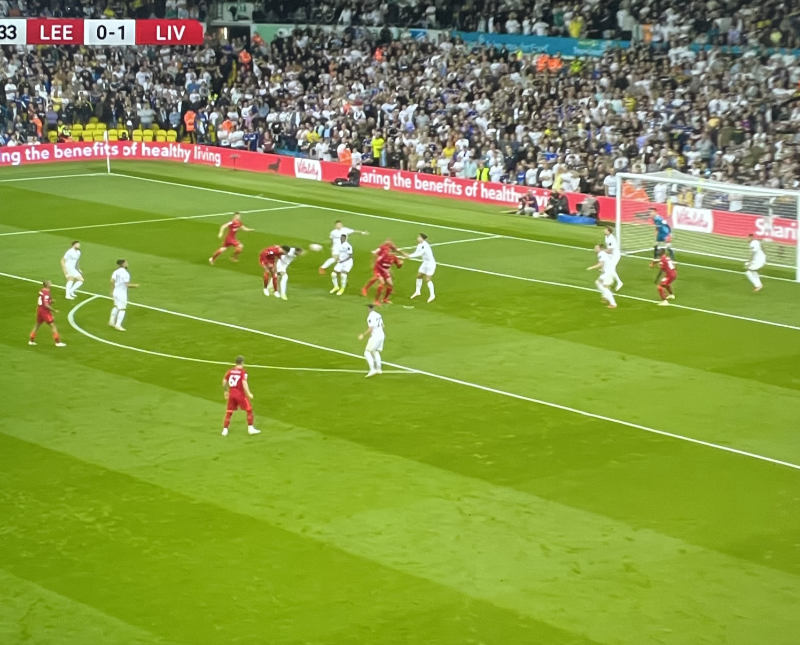
At Leeds, van Dijk wins the header, but it doesn’t go far. However, Fabinho eventually smashes the ball home. Note here how, unlike other teams, Leeds are marking Liverpool’s edge-of-the-box shooters, with a wide spread of players. So, van Dijk has more freedom to win the first header.
What do you want, a shot to the head or a shot to the heart?
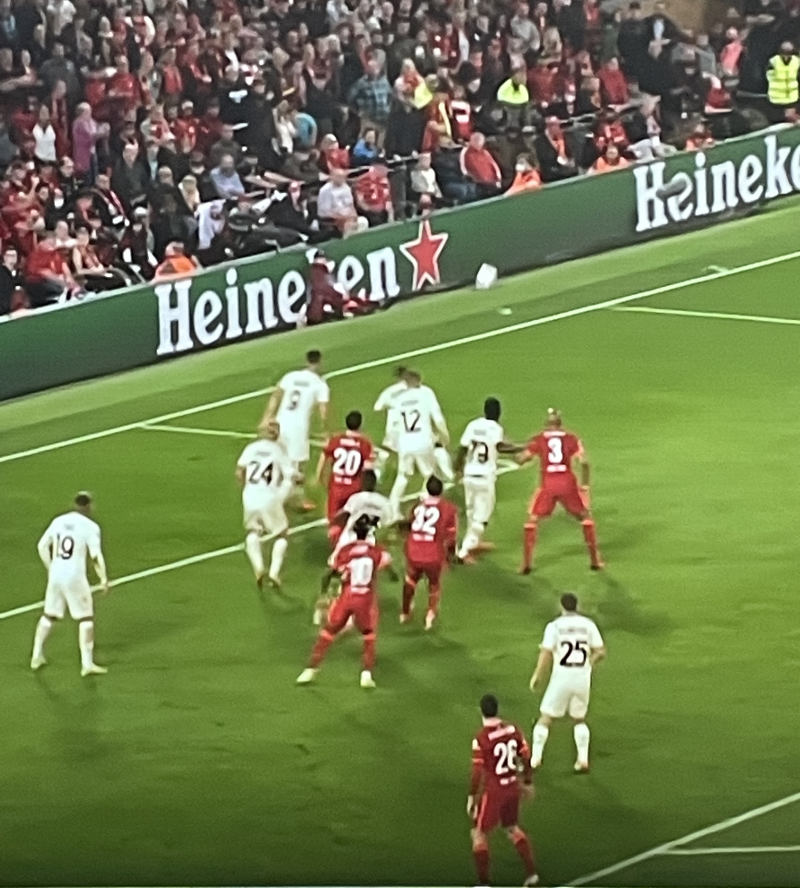
AC Milan, with no van Dijk to deal with, head clear to the edge of the box before Matip and Fabinho can get on the end of the cross. Jordan Henderson, out of the picture, lashes the ball home. Game won.
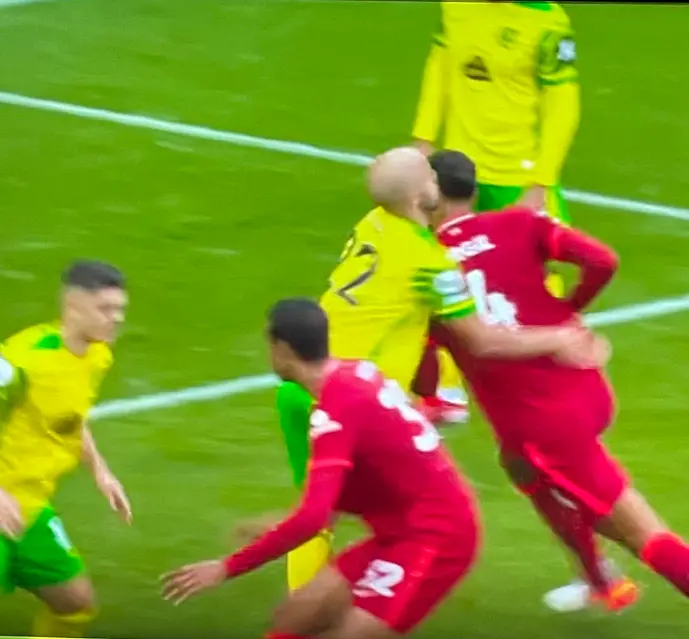
A couple of examples of how fouling Liverpool players doesn’t help. Norwich try to stop van Dijk and Matip with actual judo. No intention to even look at the ball.

Palace try to stop Konaté with actual judo. The giant Joachim Andersen can only foul the Liverpool man, and it just frees van Dijk.
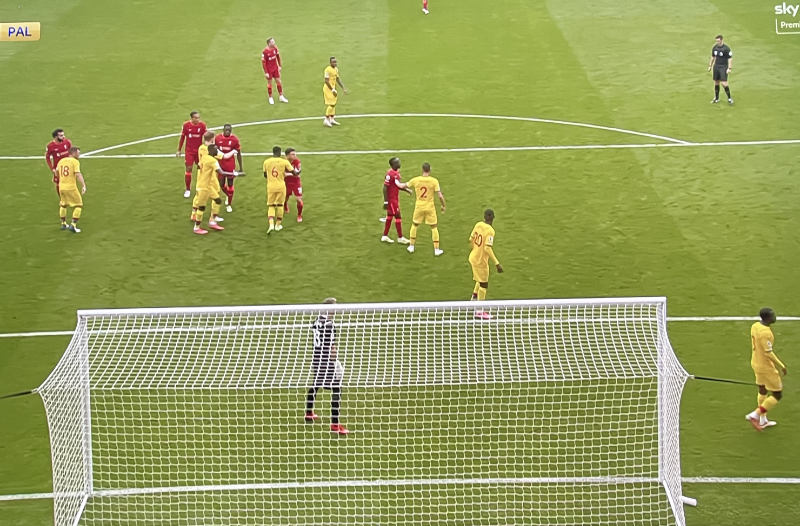
The first goal yesterday, and Mo Salah will run from left to right, as we look, into the big space. Palace will be so busy with the big guns they miss the little ‘un. Indeed, Salah’s marker gets blocked out by the mass of his own players. Palace are “touch tight” to several players, and are allowed to impede runs.
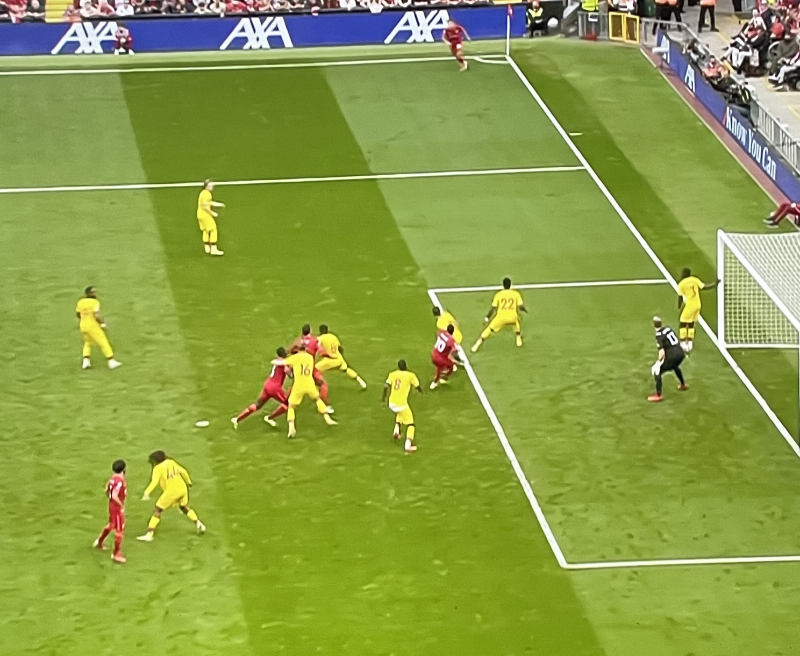
The second Liverpool goal against Palace yesterday. Palace have a decent spread, with fewer men obsessing with van Dijk and Konate, but fouling both. However, van Dijk gets a touch under pressure. Palace succeed in stopping van Dijk getting a clean header, but look at that lovely space for Mo Salah to run into if the ball drops there? (Cue ball dropping there.)
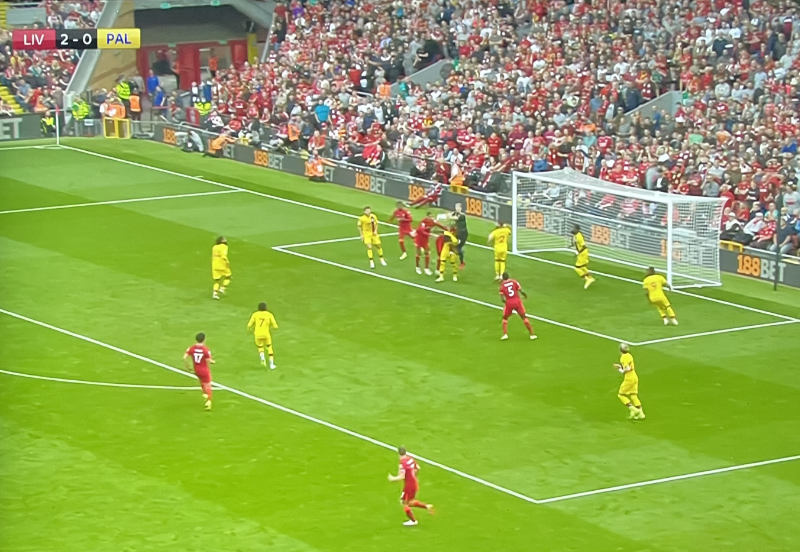
The third goal. A good punch by the keeper, in the melee. Again, Palace have a decent spread as Liverpool only have four men in the box, but where’s Naby Keita? He’s not yet in the picture, so he can’t exist, right? Doh!
Conclusion
Opponents, you’re damned if you do and damned if you don’t. Your only hope is another Liverpool injury crisis.